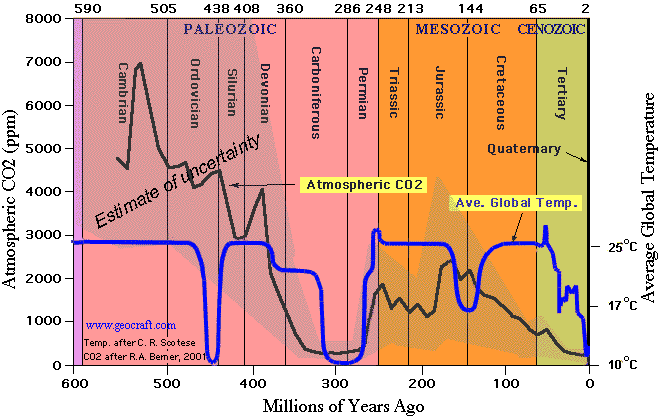The Heat Was On: Atmospheric CO 2 Triggered a Global Warming Event 40 Million Years Ago: Scientific American
Why didn't positive feedbacks turn the Earth into a permanently uninhabitable fireball?
How do we know that the elevated CO2 levels weren't an effect of warmth driven by other factors, rather than the cause of the warmth?

In a new study scientists used "paleothermometers" to gauge CO2 and temperatures that prevailed during a long-lived primordial global warming event, and found CO2 to be the culpritWhy doesn't this article ever tell us what CO2 levels were back then? According to this graph, they were about 3,000 ppm.
...
Atmospheric CO2 was the primary driver of a 400,000-year global warming event, known as the middle Eocene climatic optimum (MECO), according to a new study. The finding, which could help climatologists better understand the precise relationship between CO2 concentration and climate change today, is described in the November 5 issue of Science.
...In order to investigate the role of CO2 during this warming episode, researchers analyzed sediment taken from deep beneath the ocean floor off the eastern coast of Tasmania. The core contained a record of fossils that spanned the relevant time interval.
The researchers relied on two separate organic proxies, also called paleothermometers, to reconstruct changes in sea-surface temperature during the MECO. Both are based on variation—due to temperature change—in structural characteristics of the molecular remains of specific microorganisms. In other words, the team analyzed specific molecules in which certain variations are known to be reflective of temperature change.
...
To figure out how much atmospheric CO2 increased during the MECO, the researchers reconstructed the changes in its concentration by determining the ratio of stable carbon isotopes in organic molecules called alkenones. Variation in the composition of these molecules, produced by algae, can serve as an indicator of atmospheric CO2. Isotopic proportions are also influenced by the growth rate of the algae, which is proportional to the available food and nutrients in the water. So the authors considered multiple scenarios to account for variations in nutrient availability, concluding that CO2 concentration increased by a factor of two to three during the MECO.
James Zachos, a professor of Earth and planetary sciences at the University of California, Santa Cruz, who specializes in the time period and methodology used the study, said in an e-mail to Scientific American that apart from what may be an overestimation of the mean partial pressure of CO2, and the magnitude of its rise, "the data look reasonable."
...
Currently, climatologists have a much better understanding of the role short-term feedbacks, such as changes in water vapor or sea ice. Incidentally, there were no glaciers at the time of the MECO, so Hoeben's group could look exclusively at the relationship between CO2 and temperature without having to account for the fact that changes in the amount of sea ice can increase temperature, too. "We've shown that if you include those long-term factors, then CO2 might very well be the leading factor for temperature increase, especially in a world without a major ice sheet," Houben says.
...
The study does leave one big question outstanding: Where did all the MECO CO2 come from? This remains an area of speculation, Houben says, although scientists are fairly sure the source was not organic. However the CO2 got there, the takeaway from this study is simple: "In the past," Zachos says, "whenever atmospheric carbon dioxide levels rise, the climate warms."
Why didn't positive feedbacks turn the Earth into a permanently uninhabitable fireball?
How do we know that the elevated CO2 levels weren't an effect of warmth driven by other factors, rather than the cause of the warmth?




1 comment:
I spent 39 years in research and development, and in the laboratory where I worked we called this sort of thing "the unwarranted extrapolation of insufficient data."
Post a Comment